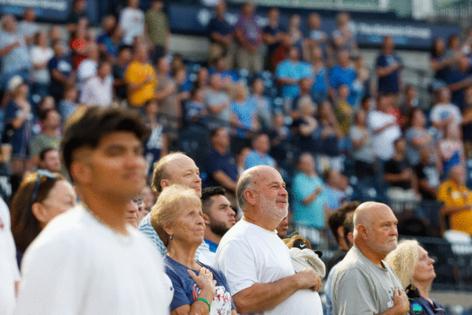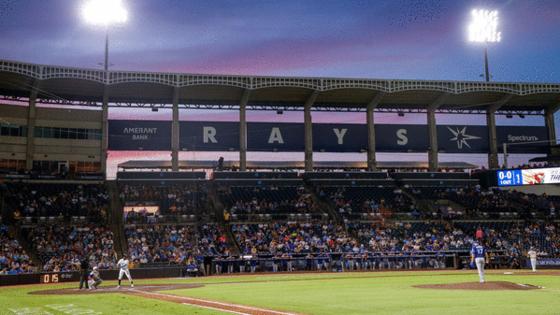Marc Topkin: For Rays, Steinbrenner Field was a good rental experience but not home
Published in Baseball
TAMPA, Fla. — As the Rays on Sunday night wrapped up their season-long stay at what some players called their Airbnb stadium, there was much about playing at Steinbrenner Field that went pretty much as they figured it would.
The facilities, designed by and for the usual spring-breaking New York Yankees, were tremendous. Rain and lightning, or at least the threat of, were frequent factors before and during games. The heat at times was oppressive, the humidity dreadful.
“Just about what we expected,” closer Pete Fairbanks said. “A lot of nice amenities, some rain delays and real hot. Playing baseball outside in Florida is going to grade out a few points lower than playing baseball inside in Florida.”
There were some things that were surprising, none more so — barring an unexpected weekend storm — than not having any of their 81 games rained out and just 11 delayed.
Also, that the stadium — with its combination of Yankee Stadium-cozy dimensions, summer heat and impactful wind due to the lack of a second deck — wasn’t the launching pad for home runs as forecast.
“I think it all evened itself out,” starter Drew Rasmussen said. “There were balls hit to left-center that probably should have been homers at times, but there were definitely some balls hit to right that shouldn’t have been.”
And there is something just about all of the Rays people agree on after their sixth-month rental, for a reported $10 million plus $5 million in improvements:
Steinbrenner Field is a great place to visit for an exhibition game or two every spring — and there is sincere and significant gratitude to the Yankees for accommodating them this season — but the Rays hope they don’t ever have to move back in.
“I’m ready,” manager Kevin Cash said, “to go back to the Trop.”
A return to hurricane-damaged Tropicana Field is planned for 2026, with city of St. Petersburg officials saying the roughly $60 million project, starting with installation of a new roof, is on track, with an April 6 reopening scheduled.
Though the Rays enjoyed some aspects of the experiment to play outdoor baseball in the summer in Tampa Bay — sunshine, fresh air, a grass field, fireworks, to name a few — they also gained a better appreciation for the experience of playing inside the air-conditioned dome they had called home for the previous 27 seasons.
“I miss the Trop,” Rasmussen said. “72 (degrees) sounds really nice every day. No rain delays sounds really nice.”
As much hard work as the Rays business, creative services and clubhouse staff did to rebrand everything they could at Steinbrenner to make their players feel at home, baseball operations president Erik Neander said it never quite felt like their home.
“It’s not an excuse in any way for anything that happened this year. The amenities were first rate, and there was an incredible setup (for the players), I think just the feeling of not being home was something that was probably a little bit stronger than I would’ve expected it to be going in,” Neander said.
“You feel like you’re sleeping on your buddy’s couch for a year and, yeah, you go to bed every night, you get your sleep and you make the most of it, but ...
“So, yeah it was great,” Neander continued. “It was everything we could ask, for given the circumstances. But I think that that feeling of it not being home and kind of not having that type of attachment and familiarity I think is something that collectively we all felt a little bit.”
From a baseball standpoint, the Rays did OK, entering Saturday’s penultimate home game with a 40-39 record at Steinbrenner, normally home to the Yankees’ Class A team, compared to 35-40 on the road.
Though not as extreme as they had been told to expect, nor among the biggest disparities in the league, they had better offensive numbers at home (.261 average, .750 OPS, 1.20 homers per game) than away (.242. .684, 1.08).
Perhaps most impressively, Rays pitchers had a lower ERA at home than on the road: 3.80 vs. 3.91.
Business-wise, the season may be an interesting case study for future college classes.
Faced with a significantly smaller capacity (10,046 vs, 25,025 at the Trop without the upper deck), the Rays raised ticket prices to offset the revenue loss.
They had reasons, with being able to tap into the Tampa market (after hearing for decades that Tampa residents didn’t come to games because of travel to the Trop) and the novelty/intimacy of regular-season games in a spring-training venue, albeit subject to summer weather. (Team-offered Groupon deals and low secondary market prices, in single digits for some games, showed supply exceeded demand at times.)
Chief business officer Bill Walsh said the Rays ended up with about the same number of season-ticket members as 2024 — some new from Tampa, some previous dropping out or taking the option to “pause” and return in 2026 at the Trop.
Similarly, they gained and lost some corporate partners, and had different arrangements with concessionaires and vendors.
The Rays sold out 59 of the first 79 games, averaging 9,704 fans. In 2024 at the Trop, they averaged 16,515, selling out only opening day.
Walsh said they felt they did the best they could.
“It still hurts, it’s still a challenge, there’s still a gap to fill,” he said. “But the stadium is only so big. You can only sell so many tickets and so many hot dogs and sodas and beers.
“But I think that the experience that was here, the fans that came out, we were able to build some really great relationships with new folks on the Tampa side of the bay in a really meaningful way. That is special and hopefully will pay some dividends going forward as we move back to the Trop and then ultimately a new home somewhere over the bay area.”
Going back to the massive amount of offseason planning, the frenzied three-day stadium makeover before opening day and the myriad adjustments (such as learning rain-delay protocols and best practices), Walsh said the season went well.
“I’m pleased with everything overall,” he said. “In light of everything that this organization faced, to be able to have a season like we had, with an incredible atmosphere, with some incredible moments on the field, there’s so many challenges to putting a major-league product on the field in a minor-league ballpark.
“Some of those we knew, and some we didn’t and found out along the way. But to be able to still overcome that and have the season that we had, just really, really proud.”
Given the initial uncertainty of where they’d play after the Trop roof was torn off in Hurricane Milton, players and staff said they were just relieved to stay in the Tampa Bay area rather than be relocated.
“This,” Rasmussen said, “has been a really good Plan B.”
Added outgoing team president Matt Silverman:
“The facilities, especially for the players, were first class. It allowed our organization, our players, our staff to remain local and embedded in the community. There were times it played like a minor-league park, because it is one. Certainly the absence of a second deck and the major-league crowds that we’re accustomed to changed the atmosphere. But all things considered, it was as good, if not better, than we could have expected going into the season.”
There were some adjustments — such as limited chances to take batting practice on the field — along with things players said they enjoyed about the experience, and learned.
“It’s been a lot of fun,” starter Ryan Pepiot said. “It’s been really hot. I’ve gotten really good at applying sunscreen and changing uniforms (due to sweat).”
Ultimately, Neander said, it’s obvious what would have made their stay a five-star experience.
“It definitely would’ve been better,” he said, “had we won more games.”
____
©2025 Tampa Bay Times. Visit tampabay.com. Distributed by Tribune Content Agency, LLC.










Comments